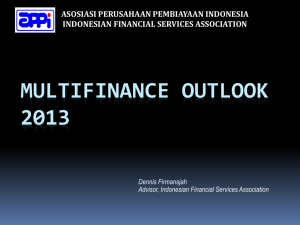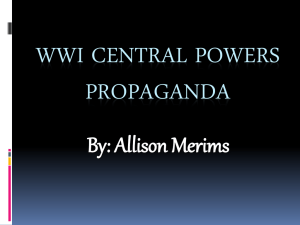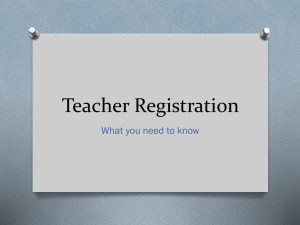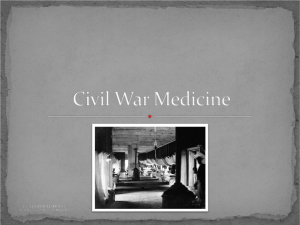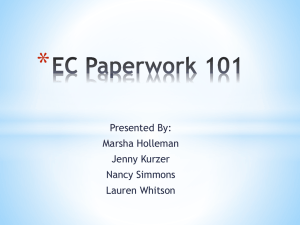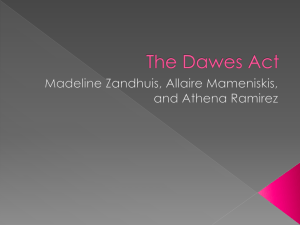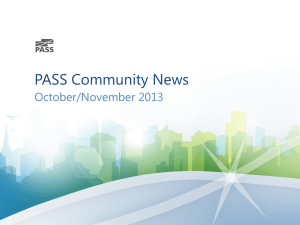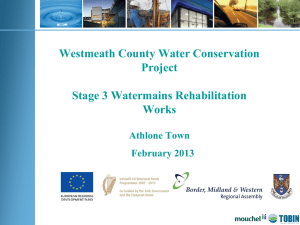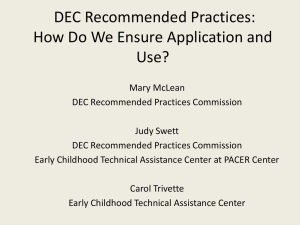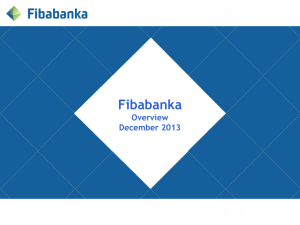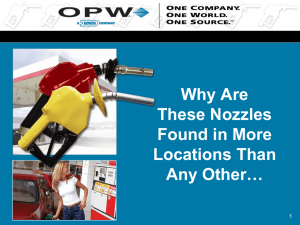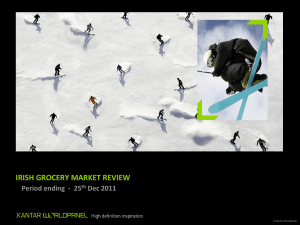Peter O Reilly Final.
advertisement
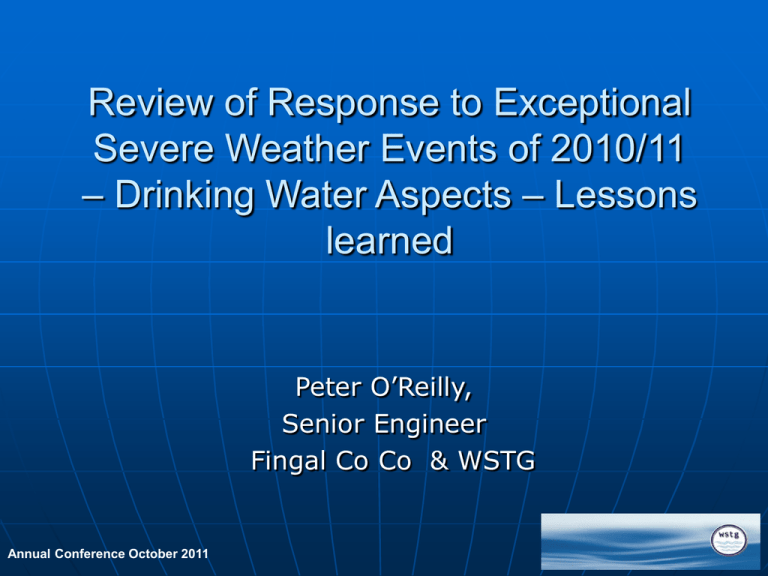
Review of Response to Exceptional Severe Weather Events of 2010/11 – Drinking Water Aspects – Lessons learned Peter O’Reilly, Senior Engineer Fingal Co Co & WSTG Annual Conference October 2011 Weather Summary Dec 2010 Lowest day & night time temperatures ever recorded in Ireland Fast thaw over 36 hours, typically: from -15o C or lower on night of 24th Dec. to +10o C or higher at midday on 26th Dec. Thaw well established across the country by 28th Dec. Westmeath Climate Conditions Initial period of low temperatures: – 22nd Nov. 2010, for 33 consecutive days, ending 25th Dec. 2010 Temperature ranged from 0 ºC to –15 ºC 50mm to 100mm snow fell on morning of 30th Nov. 2010 Rainfall (mm) Max Temp Min Temp ground min Temp Weather Event 20 10 5 0 11/01/11 Summary of Westmeath Climate Conditions 08/01/11 Date (22nd Nov. 2010 – 9th Jan. 2011) 05/01/11 -20 02/01/11 -15 30/12/10 27/12/10 24/12/10 21/12/10 18/12/10 15/12/10 12/12/10 09/12/10 06/12/10 03/12/10 30/11/10 27/11/10 24/11/10 -10 21/11/10 -5 18/11/10 Temperature 0C 15 Raw Water Temperatures Raw water temperatures fell from 6.3 ºC to 0.7 ºC over the period Period of Freezing Period of Thaw 580.0 570.0 560.0 550.0 540.0 530.0 520.0 510.0 Sun 28 Nov Mon 29 Nov Tue 30 Nov Wed 01 Dec Demand Thu 02 Dec Fri 03 Dec Sat 04 Dec Supply Sun 05 Dec Mon 06 Dec Effects of temperature rise Service Pipe Bursts Control Unit Bursts Elements of Response Call centres Communications - local radio stations /newspapers/websites Alternative supplies – tankers/standpipes Leak detection & repair Increased drinking water production Pressure reductions/shut-offs Resources (DCC) Staff redeployed Fire Service Civil Defence – vulnerable, elderly, disabled Hiring tankers and equipment Used info in DWIRP • Lists of equipment, service providers • List of suitable staff for specific roles • Contacts for special customers Examples Effect of Temperature rise on supply systems Welfare Facilities Stock of stand pipes deployed in Areas Athlone: Coole: 14 6 Kilbeggan: 17 Mullingar: 20 Standpipes were given to local Residents Associations to operate at agreed times – this arrangement worked well Communications Updates • Website & Aertel, daily/hourly • e-mails to Councillors & area offices & other LA’s • improvement: update as early as possible Informed customer services DWIRP Map – Mullingar Town Independent Valve Closures to Extend Storage Communications Website and Twitter updated on an hourly basis during the day with time of update Website and Twitter updated after hours Aertel updated on same basis Updates to all media outlets Senior personnel available for radio and TV updates each day Communications 2 Map of water supply zones & table of shutoffs Problem areas, tanker locations, special water deliveries List of questions for customer services List of special/vulnerable customers REPORT ON THE REVIEW OF THE RESPONSE TO EXCEPTIONAL SEVERE WEATHER EVENTS OF 2009 – 2010 by National Directorate for Fire and Emergency Management There should be a review of Critical Infrastructure Protection in the energy and communications sectors to ensure appropriate resilience in these services; Lessons learned from Jan. 2010 Preparations for thaw • 505 person days training on leak detection in 2010 • Night-time restrictions from early Dec. to ensure reservoirs were full • Early warnings to consumers from 20th Dec. • Staff on call over holiday period • Communications with emergency management e-mail address Athlone Seminar 1 Staff welfare • rostering, too many overtired • drafting in staff from other areas, • contracting plumbers (on Call) Call centres • many crashed, possibility of regional call centres Met Eireann • get onto alert list water treatment • Adequate stock of chemicals • Maintaining access, salt/grit stock, 4 wheel drives Athlone 2 Communication • use web based mapping for informing public Leaflets and information • should be standardised and agreed with HSE (there are templates in DWIRP) Ghost/unfinished estates, estates not in charge Shared services, need protocol with neighbouring WSAs Athlone 3 DWIRPs • complete where unfinished • cover other emergencies viz. flooding, contamination, drought DWIRP regional focus • use Regional Training Centres & Technical Committees • workshops Relevant workshops • e.g. use of Social Media for emergency communication Have you a DWIRP ? DWIRP manager and deputy Training - WSTG, in-house DWIRP prepared, notify EPA Protocols with HSE Liaison with Group Schemes & DBO contractors Resources and Equipment Liaison with neighbouring WSAs In-house training, exercises, reviews Scope of DWIRP All Incidents: • Contamination • Interruption • Severe weather All aspects of the drinking water system: • Sources • Treatment • Distribution System to the consumer's draw off point. “Water Suppliers" • Water Services Authorities • Group Water Scheme sector. DEHLG L4/2009 DWIRP Manager Implement asap Co-ordinate with neighbouring WSAs Protocols established with HSE Sharing resources with other WSAs In-house training Situation exercises EPA WSAs must prepare a written DWIRP Appoint senior persons as manager/ deputy manager of DWIRP who should: be fully familiar with WSA and operations prepare and maintain DWIRP in consultation with other staff circulate as controlled document co-ordinate the resources needed organise training staff of WSA on the DWIRP rehearsing and testing the DWIRP reviewing and modifying the DWIRP following incidents May need additional Subsidiary Plans Site specific plans Severe Weather Chemical release Industrial action DWIRP – have you reviewed & updated? All incidents not just severe weather Appendices – continuous process Plan Post-exercise Post-incident Annual Review Full review as appropriate DWIRP review Team structure - roles & responsibilities Procedures & forms for communications Lists of equipment suppliers Contact details for suppliers, other Local Authorities Support - staff redeployment, Civil Defence Lists of special customers • Hospitals • Nursing homes • Schools DWIRP Risk Assessment - example V(very high); • Reduction of source due to drought H (high); • • • • • • • • Chemical pollution of source Waterworks breakdown for more than 5 hours Total pump failure for more than 5 hours Loss of electricity for more than 5 hours Microbial exceedance in supply Cryptosporidium in supply Major bursts on trunk mains Flooding of properties/ roads due to burst main Draft DWIRP Incident Log Date incident declared; Brief summary of incident; Date Detailed History of Events Summary if incident (scale, severity etc); Liaison with External Agencies: Communications Used; Lessons learned: Closeout date: DWIRP Number (e.g. GCC-DWIRP-2010-Amb01); Signed: _____________ Frank Clancy, A/SEE, Water Services Outcome/ Decision Draft DWIRP Incident Log Date incident declared; not declared yet – still able to deal with using routines Brief summary of incident; Low River levels following dry spell and weir gates being open during part of this period. Date Events report Outcome/ Decision 2/9/2010 Problems caused by low river levels, we could not treat more than 1,200 m^3/ hour approx. Tonabrocky and Clifton Hill very low. Outages in Barna, Moycullen 3/9/2010 Meeting with Co. Co in morning to discuss. GCC agreed to throttle back City flow later in evening. Co. Co providing as much as possible to Coolagh Kept pumping as much as possible. Co. Co. had a problem on 5th and reduced our supply. This caused us problems overnight and we lost all the gains. Low reservoir levels in Clifton Hill and Coolagh so pumping to both sides. River level improved so increased plant throughput. Increase from 150m^3/h to 300m^3/h from Luimneagh allowed us pump more to West. Comms down all day due to Eircom problem Meeting with Co. Co. in afternoon and agreed joint statement for the websites Restored comms to Clifton Hill and Tonabrocky in the evening Reservoir levels all low but production up to 1,900 and import from Luimneagh back uo to circa 500m^3/h. River level improving Reservoirs steadied overnight and river level up above 0.8 for first time in c 2 weeks. OPW opened gates in morning. Phone and email to OPW asking them to maintain river level, gates closed and level returned after dinner Contact Coco. for more water, Contact OPW re closing gates Notice to local radio Throttle back City flow late evening Notice to local radio for weekend 4, 5/9/2010 6/9/2010 7/9/2010 8/9/2010 9/9/2010 Clifton Hill and Tonabrocky up to circa 2.3m in morning 10/9/2010 Clifton Hill and Tonabrocky up to nearly 3m in morning Contact with Co. Co. (cannot give us more until couple of days) Joint statement on County and City websites Joint statement on County and City websites Email to OPW Throttle Tonabrocky in evening to help bring up level overnight Have you a DWIRP Quick Guide ? “DWIRP light” Bullet points One page “quick guide” for staff – relevant info Telephone list • Critical staff • Suppliers • Equipment • HSE, EPA (if nec), etc DWIRP Quick Guide Quick Guide for DWIRP – Galway City Council (Rev 1 May 2011) Major Burst, large water outage etc. 1. Phone calls between COW, EE, SEE with initial information. 2. Email to customer services, press officer, DOS, website, Fire Station, admin staff answering phones at waterworks etc.[Distribution List]. Include brief notice that there is a problem, it is being investigated by water staff and overview of area affected. 3. Above information to website person and local press. 4. Start DWIRP log with initial events. 5. Follow up email later when more information is known on extent of problem, likely duration, works being done etc. Do this even if it is very similar information to previous. Relevant section of DWIRP; Appendix A.7, B1; Protocols for outages (planned and emergency) including FAX template for local radio. Appendix A.9; Incident Log Sheet Appendix B.2; List of sensitive customers Appendix C.2; Group Water Scheme details Appendix D.1; Guidance on deployment of water tankers DWIRP – Have you reviewed your communications plan? What do people want? • Clear information – No jargon • Whats happened • Why it has happened • When will it be sorted • That someone is in charge Advance circulation of Information Leaflet on necessary steps for protection of their water supply Emergencies Are sudden Stretch resources Break continuity/confidence in service Need different levels of response as they vary in size and complexity Can involve a large number of stakeholders Staff requirements Experienced Competent Well trained Ready and available to respond Resources Next (WSTG) Raise issues with CCMA Workshops • • • • Completion of DWIRPs Review preparedness Create networks & exchange experience Protocols for sharing resources DWIRP review • Apply experience learned to date Conclusions Emergencies happen Be prepared Have a plan - DWIRP Acknowledgements Gerry Galvin, Principal Advisor, DECLG Laura Walsh, Dublin City Co Morgan Cox & Greg Duggan, Westmeath Co Co Frank Clancy, Galway City Co Helen McDonnell, Meath Co Co Corporate Community
